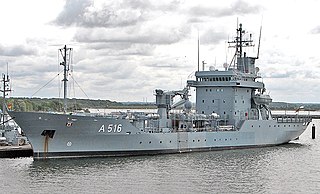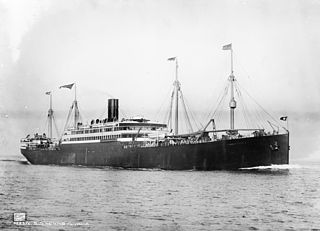This page is based on this
Wikipedia article Text is available under the
CC BY-SA 4.0 license; additional terms may apply.
Images, videos and audio are available under their respective licenses.

Holland America Line is a British/American-owned cruise line, a subsidiary of Carnival Corporation & plc. Originating in the Netherlands, the company moved its headquarters to Seattle, Washington, United States.

SS Robin is a 350 gross registered ton (GRT) steam coaster, a class of steamship designed for carrying bulk and general cargoes in coastal waters, and the oldest complete example in the world. One of a pair of coasters built in Bow Creek, London] in 1890, the ship was built for British owners, but spent most of her long working life on the Spanish coast as Maria.
The Lake Torpedo Boat Company of Bridgeport, Connecticut was an early builder of submarines for the United States Navy in the early 20th Century.

The Type 404 Elbe class replenishment ships of the German Navy were built to support its squadrons of Fast Attack Craft, submarines and minesweeper/hunters, as such they are usually referred to as tenders.

SS Deutschland was a passenger liner built in Stettin and launched in 1900 by the Hamburg America Line of Germany. The rival North German Lloyd line had launched Germany's first four funnel liner, Kaiser Wilhelm der Grosse in 1897, and SS Deutschland was built by Hamburg America as Germany's second four-funnel liner in order to compete.

USS DeKalb (ID-3010) was a German mail ship Prinz Eitel Friedrich that served during the early part of the First World War as an auxiliary cruiser (Hilfkreuzer) in the German Navy and later after the US entry into the war, as US Navy troop ship. Post war she returned to civilian service as the US transatlantic liner SS Mount Clay.

A barracks ship or barracks barge, or in civilian use accommodation vessel or accommodation ship, is a ship or a non-self-propelled barge containing a superstructure of a type suitable for use as a temporary barracks for sailors or other military personnel. A barracks ship, a military form of a dormitory ship, may also be used as a receiving unit for sailors who need temporary residence prior to being assigned to their ship.

SS Pennsylvania was a cargo liner built by Harland & Wolff, Belfast
and launched in 1896 for the German Hamburg America Line for the transatlantic trade, particularly German emigration to the United States. She took refuge in the United States upon the outbreak of the First World War and upon the U.S. joining hostilities was seized and renamed the SS Nansemond. She was briefly commissioned as USS Nansemond in 1919,
and used by the U.S. military to transport American troops and supplies to Europe. After the war ended, the SS Nansemond transported over 20,000 troops back across the Atlantic. She was then laid up in the Hudson River before scrapping in 1924.

The 4"/50 caliber gun was the standard low-angle, quick-firing gun for United States, first appearing on the monitor Arkansas and then used on "Flush Deck" destroyers through World War I and the 1920s. It was also the standard deck gun on S-class submarines, and was used to rearm numerous submarines built with 3-inch (76 mm) guns early in World War II. United States naval gun terminology indicates the gun fired a projectile 4-inch (102 mm) in diameter, and the barrel was 50 calibers long.

SS Prinz Friedrich Wilhelm was an ocean liner for North German Lloyd (NDL) from her launch in 1907 until the end of World War I. After the war, she briefly served as USS Prinz Friedrich Wilhelm (ID-4063) for the United States Navy returning American troops from France. The vessel was first chartered—and later purchased outright—by Canadian Pacific Steamships (CP) and operated under the names Empress of China, Empress of India, Montlaurier, Monteith, and Montnairn. She was scrapped in 1929.
SS Hong Moh was a passenger ship that was wrecked on the White Rocks off Lamock Island, Swatow, on 3 March 1921 with the loss of about 900 lives.

The Rivers class was a class of eleven ocean liners of the Norddeutscher Lloyd (NDL), the first class of German express liners. The ships were built between 1881 and 1890, the first nine in Glasgow by John Elder & Co. or the renamed Fairfield Shipbuilding and Engineering Company, the last two in Stettin by Vulcan. All were named for rivers in Germany.
SS San Wilfrido was a 6,458 GRT steam-powered British tanker which was built in 1914 by Armstrong, Whitworth & Co Ltd, in the Low Walker yard. The ship was operated by Eagle Oil Transport Co Ltd. San Wilfrido was sunk by a German mine on 3 August 1914—one day before Britain formally entered the First World War. It was Britain's first naval loss of the war.
SS-Oberabschnitt Elbe was a division strength command of the Allgemeine-SS which encompassed the General SS-commands of central east Germany, in today what is near to the border of the Czech Republic. During the Second World War, the Oberabschnitt was considered part of War District IV and was under the authority of an SS and Police Leader of the same name. Administratively, the Oberabschnitt leader and the SS and Police commander were typically the same person.
Elbe is a river in the Czech Republic and Germany.
SS Humber was a passenger and freight vessel built for the Goole Steam Shipping Company in 1903.
SS Bury was a passenger and cargo vessel built for Britain's Great Central Railway in 1911.









